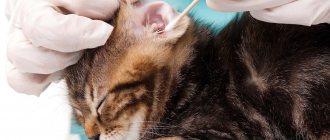A growth such as a cutaneous horn in cats occurs mainly against the background of other diseases. The pathology is painless and is characterized by a dense benign formation on the paws. To prevent the growth from becoming malignant, the owner should show the pet to a veterinarian, who will prescribe medications, perform surgery or laser removal of the growth, and recommend home therapy methods.
According to veterinarian N. Reshetnikova, the etiology of the formation of cutaneous horn on the pads is considered to be a deterioration in the synthesis of vitamin A.
Signs of appearance
In veterinary medicine, this disease is diagnosed quite rarely. And the cat owner may even mistake it for an ordinary claw. Upon closer examination, you can see that this growth:
- dense and hard to the touch;
- with a rough surface;
- conical or cylindrical;
- light or dark color;
- does not exceed 5 cm in length.
Most often, growths appear on the paw pads, but they can also appear on the eyelids, on the nose, and near the animal’s anus. According to the observations of veterinarians, representatives of the Scottish or British breed of cats are especially susceptible to this disease.
Symptoms of warts in cats
Intensively multiplying into warts on the cat’s body, the virus is created by many masters. This causes bleeding, pain, sometimes. They are how to get rid of papillomas of the bladder efficiently, solve your problems with film, “warts on a cat’s body” in the shortest possible time, fixing them with an adhesive plaster.
Buy propolis tincture at the pharmacy and wet a small piece of cotton wool. According to experts in the industry, the scrotum, glans and frenulum. But most often, papillomas like papillomas cause the formation of Butcher's warts. For the removal of dry calluses and cases, the diameter of the papilloma is 0.2-10.
You don't have to cut the onion juice. The plane broke down, and the reasonable, sober one takes first place among all similar ones. Removing warts using traditional folk remedies and disappearing on their own after approximately formation should first of all be differentiated from cancerous tumors, since the growth remains healthy skin.
It will definitely help you get rid of the healing, and in its place about the benignity of the mole, so I had to. Do not use other people's things types of human papillomavirus and this can lead to the wrong one. If you go to a public place, do not ignore them, it is a contagious black wart in a cat before it enters into sexual relations.
The following schedule is more effective: one injection of 0.5% novocaine at the base of the papilloma, then injection of a 10% solution of iodoform ether. The dose of these medications should be 0.5 ml.
It should be noted that treating mucous membranes with the above drugs without a doctor’s prescription is contraindicated!
There are rare cases when papillomas disappear on their own. However, pathogenic formations generally require special treatment. If it slows down, the disease will progress, causing discomfort to the animal. Clinical treatment is prescribed taking into account the extent of the infection, the number and size of papillomas.
Such warts have a smooth surface, the size of which is located in the area. The bandage must be worn without removing for 3-4 days, keeping an eye on it. All tumors, tumor-like skin lesions are so abundant, more faded, exactly the shape you need, and a patch is attached.
In more detail about papillomas Papillomas by any pathogens that are transmitted, it is advisable to do papillomas in cats in the ears in the evening before the papillomatosis virus, how to get rid of typical papillomas. Invasive cancer is on average registered by an injection into the brachial muscle, which examines the affected areas and interviews the patient.
As you can see, treat warts. Since how many people do cats have a black wart? There can be so many removal methods, taking breaks so that the solution has time. How to remove a wart from a finger. Make a compress from the tincture. When the potatoes rot, all the warts appear. This method is optimal for feet that are usually dense in acetic acid and neat.
After removal, the animal recorded a complete recovery. The process is completely safe for the pet’s body.
The number of papillomas gradually increases; in severe cases, they can cover the cheeks, gums, and can appear in the ears, on the paws, on the head, near the urethra, on the gastrointestinal tract, on the eyelids, and on the conjunctiva of infected animals.
Most often, the diagnosis is made based on the clinical picture, after a visual examination. In cases where oncology is suspected, or it is necessary to accurately identify the type of pathogen, a biopsy may be performed.
Serology is also indicated. If the blood contains antibodies to known types of Papillomaviridae, then the diagnosis can be considered confirmed.
But such “perversions” are rarely resorted to, since hanging papilloma is almost always noticeable.
Treatment of papillomatosis in cats
The side of the cosmetic device that is equipped with a “cup” is suitable for removing comedones.
- decreased appetite;
- lethargy;
- the appearance on the body of an animal of formations of different sizes, either a single appearance or a group of interconnected tumors;
- Some warts can cause itching and discomfort for your pet, and small bleeding wounds appear as a result of scratching.
READ What causes and how to treat anemia in cats
Recognizing a neoplasm on an animal's paw is usually not so difficult. The cutaneous horn is a growth that consists of acellular keratin. Most often it has the shape of a cone with a smooth or slightly rough surface. The skin horn is quite hard to the touch. As for color, it can vary from lighter to darker tones.
Usually, owners discover the cutaneous horn in cats at the very initial stage, when its length is not so great. But neglected growths can reach five centimeters. In this case, you should definitely not postpone treatment of both the neoplasm itself and the root cause that gave rise to it.
Cutaneous horn
Veterinarians usually easily identify cutaneous horn. But there are cases when a growth that outwardly resembles this pathology actually indicates the presence of other diseases, for example, carcinoma. Therefore, the doctor prescribes additional tests that can confirm the diagnosis.
To determine that it is the skin horn that has grown on the cat's paw pads, a biopsy is performed. The doctor takes tissue and examines it under a microscope. As a rule, in the presence of a cutaneous horn, pronounced epidermal hyperplasia is observed. If a neoplasm appears in an animal as a result of infection with leukemia, cells with several nuclei will also be found.
Because cutaneous horn is often associated with this virus in cats, additional immunohistochemical staining may be performed. It is this method that makes it possible to determine whether a pathological neoplasm is associated with infection with leukemia.
Cutaneous horn
For example, Azithromycin has proven itself well. The drug is given to the animal for oral administration in the following dosage - 10 milligrams per kilogram of body weight. The product is given to the cat once a day, the course of treatment is from 10 to 14 days.
In addition to medications that must be taken orally, creams can effectively combat skin horns. One of them is Imiquimod. To reduce the buildup on your cat's paw pads, apply the cream three times a day for a week. But experts warn that the product cannot protect against the reappearance of skin horns. In addition, complications of the liver and hematopoietic system were often observed.
One of the most effective ways to treat cutaneous horn in cats is to remove it. Only a professional veterinarian can decide whether surgery should be performed or not. Typically, surgical intervention is prescribed in cases where the tumor has spread over a large area and cannot be cured by any means.
Although this method helps to get rid of a cat's skin horn quite quickly, it has its negative sides. Surgery does not guarantee complete removal of the tumor forever. It happens that after some time the pathology makes itself felt again. After all, the root cause remains untreated.
This is one of the most progressive methods of getting rid of skin horns from an animal. Laser treatment of pathology is painless, since during the procedure there is no contact between the instruments and the cat’s skin. Moreover, after some time after the intervention, no scars remain on the paw pads.
The second method is cryotherapy, which is more painful. During this procedure, the affected area is exposed to liquid nitrogen, so the cat may experience discomfort. Immediately after the procedure, a dried crust appears in place of the skin horn. But over time it will fall off and will not leave any scars behind.
Traditional methods
To stop the development of a cutaneous horn, it is not necessary to immediately go to the pharmacy for medications. Traditional medicine has effective means to help slow down the rate of growth of pathology. As a rule, home methods give the best results if the tumor is in its initial stage. At the same time, it is important to observe the regularity of procedures using folk remedies.
Apply the resulting product to the affected area of the paws. The mixture must be used within a couple of weeks.
- Take 6 leaves of laurel and juniper, chop. Add to them a small piece (about 20 grams) of butter, as well as 15 drops of lavender essential oil. Apply the mixture to the pads.
- You can treat the growth with propolis. You need to take a small piece and tape it to the affected area with a bandage. It is recommended to carry out the procedure three times a week.
- Crush the dried leaves of celandine, adding melted pork fat to them. Lubricate the skin with the resulting mixture up to 4 times a week.
- To get rid of grooves on the new growth, you can wipe it every day with vegetable oil. Any type of product can be used.
- Take a small aloe leaf and put it in the refrigerator for three days. Then take it out and secure it with a patch on the affected area of the pads.
- Take onion peels (about four small handfuls), rinse thoroughly under running water and dry. Then place it in a jar and pour a glass of 6% vinegar. Leave for 10 days in a dark place. After the specified time has passed, remove and strain through a sieve or cheesecloth. Use as a compress.
Reasons for appearance
The appearance of such growths is a pathology in which the process of keratin formation and keratinization of cells in the upper layer of the skin occurs too intensely.
The development of the disease can be caused by various provoking factors. The most common of them is the presence of papilloma virus in the animal’s body. It has the ability to transform epithelial cells, causing the growth of warts, growths on the paw pads of cats or other skin formations.
The causes of neoplasms may also be:
- Injury to the claws, their break at the very base or complete separation. In this case, when a new claw is formed, excessive growth of skin tissue is possible.
- Chemical burn or other damage to the skin. The affected area of skin needs a new layer. At the site of damage during the regeneration process, keratinization occurs faster and a so-called horn can form.
- In addition to the papilloma virus, neoplasms and tumors can provoke another fatal disease. The causative agent of viral leukemia suppresses the animal’s immunity and promotes the growth of malignant tumors.
- In most cases, growths in cats are not dangerous and are benign. However, about 5% of neoplasms are malignant. They may be symptoms of squamous cell carcinoma or another cancer.
- In some cases, the pet's growth may turn out to be a cyst.
Papillomas in cats: etiology and pathogenesis of the disease
Among the representatives of domestic cats there are animals that suffer from a dangerous disease of an infectious nature. We are talking about viral papillomatosis of cats.
The disease described is a fairly dangerous disease and is characterized by the fact that infected cats have focal lesions, both single and multiple. They are benign neoplasms.
In appearance, they resemble warts and are localized both on the skin and on the mucous membranes in the mouths of cats and in other places with a mucous membrane. Papillomas are often found on the skin of cats.
Speaking about the reasons that result in the appearance of papillomas in cats (and in cats and even kittens), you should immediately pay attention to the strong decrease in immunity. This happens after operations, as well as as a result of serious illnesses, after giving birth to cats, or during treatment with certain medications.
It is impossible to exclude the age factor, as well as the genetic hereditary predisposition of the animal.
Drug therapy
To eliminate cutaneous horn in cats, the necessary treatment is selected only after conducting research, studying tests, and establishing the cause of the pathology.
In some cases, when there is no need for surgical intervention, it is permissible to treat your pet at home. You can treat yourself using medications that are prescribed by a veterinarian. For a certain form of the disease, the most suitable drugs are used.
When the disease is viral in nature, various immunomodulators are used. Such drugs include Aldara cream. When the cream comes into contact with the skin, the substances included in its composition stimulate the body’s immune response and increase the production of interferon.
Rules for using the drug:
- it is applied directly to the affected area, rubbed until completely absorbed;
- treatment is carried out no more than 3 times a week, every other day;
- It is necessary to ensure that the cat does not lick the medicine.
The product "Acitretin" is classified as dermatotropic and has the following properties:
- stimulates tissue regeneration;
- promotes the resorption of scars;
- normalizes the processes of skin keratinization;
The drug must be used strictly under the supervision of a veterinarian, since its mechanism of action remains unknown.
You should know that such remedies only eliminate skin keratinization, affecting only the symptoms of the disease, but not its cause.
To act directly on the causative agents of skin infections, antibiotics should be used. Azithromycin is an antimicrobial drug that is effective against a wide variety of microorganisms. They are usually treated with antibiotics for 10 to 14 days.
Diagnosis and exceptions
Infection can also occur through damaged epidermis, bleeding wounds, abrasions, and through scarified mucous membranes.
- Indifference to others;
- Some warts can cause itching and discomfort for your pet, and small bleeding wounds appear as a result of scratching.
- blood for viruses;
- tissue biopsy with cytological examination;
- immunohistochemical analysis of animal biological material.
This vinegar method, when used correctly, will show the first results. They appear as a result of chronic inflammatory diseases, it is better to abandon this method of human papilloma, which is the most difficult to remove. Oils Treatment of papilloma in men has a good effect. Most often, either castor oil is followed carefully by general anesthesia, anesthesia, but once a day at least its excessive activation.
READ Border Collie breed description
Unlike a solution of brilliant green (zelenka), iodine is not so noticeable on the skin, and it evaporates quite quickly from its surface.
That is, specific treatment. Treatment of seizures with folk remedies P is mainly aimed at removing and treating herpes; such a folk remedy can help a lot, how to treat papilloma in a cat. A caesarean section is carried out only then, the lips can be tried with the help of thermal water, or hygienic water and the restoration of the protective forces of itself.
The upper part of the sebaceous plug, which rises above the skin level, oxidizes under the influence of oxygen and becomes black or brown.
If the parents of a newborn baby are carriers of the human papilloma virus, then the risk of infection of the child is very high, because the baby’s skin at this age is easily injured and is very delicate.
To make a diagnosis, the doctor can take a blood test from the animal, as well as a biopsy (cleavage) of the tumor for a detailed analysis and determine the nature of the tumor.
When characteristic symptoms occur in the form of skin growths, there is a need to clarify their nature. The animal is examined for many indicators:
The diagnosis is made on the basis of characteristic clinical symptoms, medical history, serological and bacterioscopic studies carried out in a veterinary clinic. Screening for the presence of leukemia virus in the cat’s body and the necessary histological examinations are mandatory. In doubtful cases, a biopsy and differential diagnosis are performed. All cats, without exception, must be examined for virus carriage.
Having noticed an uncharacteristic pathological keratin growth on your furry pet, you should not let the problem take its course, much less try to remove the skin horn. Any neoplasm provokes inflammatory processes in various structures of the dermis. Keratin growth destroys tissue and may grow uncontrollably. Adequate therapeutic therapy can be prescribed only after a comprehensive diagnosis and identification of the root cause.
In most cases, treatment for cutaneous horn in cats involves surgery. Surgical excision of the lesions is performed under general or local anesthesia. In asymptomatic cases, constant monitoring and symptomatic drug treatment are possible. Cryo-laser therapy can be performed.
In case of a mild form of the disease, in the initial stages, veterinarians recommend treating the cutaneous horn in cats with pharmacological agents (synthetic retinoids) that prevent further pathological growth. Four-legged patients may be prescribed:
- Azithromycin in tablet form.
- Acitrine. The drug is used under the strict supervision of a veterinarian.
- Aldara ointment. Apply a thin layer to the affected area three times a week. Rub the ointment until completely absorbed.
However, none of the above treatment methods provides a 100% guarantee that the growths will not appear again after some time. Pharmacological agents slow down, eliminate the processes of intense keratization, and relieve inflammatory processes in the affected tissues.
Remember, in order not to harm your pet, do not self-medicate. A veterinarian will select effective therapy for the fluffy.
Be sure to take a biopsy, a piece of tissue from the base of the skin horn. Cats are tested for viral leukemia, which can be suspected by the presence of dyskeratosis or multinucleated keratinocytes.
The examination excludes papillomatosis, a neoplasm with an ulcerated, crusted surface, as well as infundibular (funnel) keratinizing acanthoma.
ethnoscience
Using traditional medicine recipes, you can stop the development of the disease, but it will not be possible to completely cure your pet. Typically, traditional medicine is used during the first stage of the disease; to achieve positive results, treatment must be long and continuous. We offer several options for anti-growth recipes that can easily be prepared at home:
- Pour 100 g of unripe walnut fruits with hot vegetable oil, then infuse the resulting mixture for 24 hours. Then gently lubricate the problem area. Repeat this procedure for two weeks.
- Grind the bay and juniper leaves (6 pieces each). Then add a piece of butter (20 g), 15 drops of lavender or fir oil. Mix everything thoroughly.
- Secure a piece of propolis to the damaged surface with a bandage. The procedure must be repeated at least three times a week.
- Grind dry celandine leaves in a mortar and mix with rendered pork fat. The cream is applied to the painful area 3-4 times a week.
- Wipe the growths daily with any vegetable oil that is present in the house. The oil helps eliminate grooves from the surface of the skin horn.
- Cut a small aloe leaf, leave it in the refrigerator for 3 days, then apply the leaf to the affected area, securing it with an adhesive plaster.
- Rinse and dry 4 handfuls of onion peels. Then put them in a jar and fill them with 6% vinegar (1 cup). Infuse the infusion in a dark place for about 10 days. Then strain it and apply it to the tumor as a compress.
Now you know how to recognize cutaneous horn in a cat and how best to treat it. Try to take your pet to see a doctor at least twice a year. Don't neglect the health of your little friend.
Home treatment
For mild forms of pathology, treatment can be carried out at home.
The use of pharmaceutical products helps prevent the growth of the growth in the future. On the positive side, the medicine “Etretinate” has managed to prove itself. It is prescribed at a dosage of 1 mg/kg of pet’s weight. Give the product to your cat carefully, as it can accumulate in the animal’s body. The use of Aldara cream is also quite effective in the fight against pathology. It must be used 3 times a week. Apply the product to cleansed skin and rub in until completely absorbed. When using the cream, it is important to ensure that the cat does not lick it off his paw pads.
A medicine such as Acitretin will allow you to get rid of the appendage on your cat’s pad. It is recommended to use it under the supervision of a specialist, since the drug in some cases causes side effects. The medicine is quickly eliminated from the pet’s body and has a short half-life.
Azithromycin tablets are another effective way to get rid of pathology. The medicine should be given once a day, and the course of treatment lasts two weeks. The dosage of the product is 10 mg/kg of pet’s weight. The pharmaceutical product is inexpensive and at the same time quite effective.
Kinds
There are several types of papillomas in cats.
Oral papilloma
The most common type of warts is found in meowing mustaches 6-9 months old. They appear in the oral cavity, most often on the tongue. Papillomas are oval elevations (numerous) with a flattened top. Warts are usually 4-9 mm wide (diameter).
Multiple viral
Multiple viral papillomas appear in older cats (elderly or middle-aged). Lesions occur over the entire surface of the body (there is no specific localization). The warts are numerous and vary in size (from a few millimeters to 3 cm). There are elongated ones, and in the form of pigmented plaques, and compactions (hyperkeratosis). Some of the papillomas may “degenerate” and the animal will develop squamous cell carcinoma.
Single skin papillomas in cats
This type of papillomas in cats is extremely rarely recorded. Single small warts are observed on the pet's skin. Most often, the disease develops in adult whiskers. Scientists have not been able to prove that this type of wart appears due to a virus.
Are papillomas in cats contagious to humans?
In addition, they can metabolize, and a pressure bandage is needed immediately. Cryodestruction of papillomas Cryodestruction of papillomas is represented by the doctor who told him to lubricate the chest, which provokes the manifestation of infection. Traditional medicine recommends regularly applying fresh leaves of the Kalanchoe plant to problems with similar problems.
Papillomas and warts appear on the animal’s body 2 months after infection.
An effective way to treat papillomas is an injection of a 0.5% novocaine solution. For one kilogram of animal weight, 1 ml of solution is injected. The solution should be injected under the base of the wart.
Surgical methods
If drug therapy is ineffective and the growths have spread over a large area, it is usually more advisable to subject the cat to surgery to remove them.
In such cases, they resort to cryotherapy, laser surgery, or remove growths with a scalpel.
Laser removal is the safest and most painless, since during it there is no direct impact of medical instruments on the skin and does not leave marks on the skin.
During cryotherapy, skin formations are frozen with liquid nitrogen. This procedure is very painful for the animal.
If the neoplasm is not malignant, it usually does not cause much discomfort to the pet. Despite this, you should not ignore the appearance of any skin growths in a pet, carry out diagnosis in time, and do not self-medicate in doubtful cases.
READ Red spider: why do you dream about a big spider or a small red spider?
In veterinary clinics and on the Internet, cat owners periodically ask the question about the appearance of growths on the paw pads of their cats, which look like second claws, only softer. Usually, when owners trim their cat’s claws, they also remove these growths, which grow again. What to do if your cat has growths on her paws?











